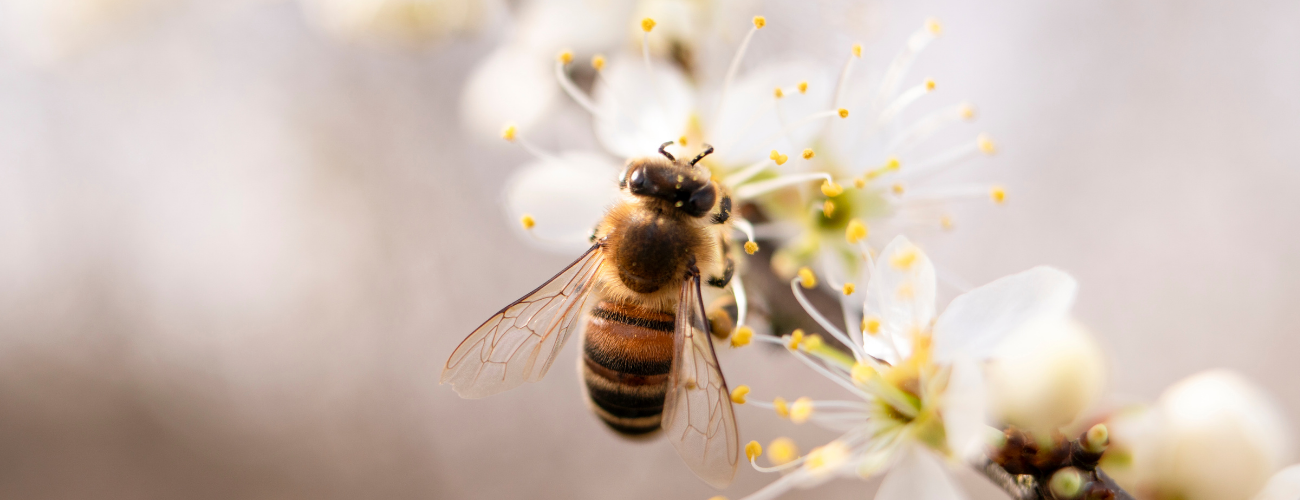
Why You Really Should Care About the Decreasing Population of Bees and Pollinators
This article was written by Rhianna Reckmeyer
We've heard it once, we've heard it a million times. "Save the Turtles", "Save the Bees", and "Save the Pandas". While we hear and see marketing for these issues, few people spend any time contemplating the significance for the plight at hand. We still see bees buzzing around the neighborhood, so how bad can this pollinator population crisis be? Well, it could be catastrophic. I'm not being sensational, keep reading.
It's true that you might need to whip out a magnifying glass to see what is actually happening when a bee is pollinating a flower, the impact of this action (when carried across an entire ecosystem) is huge. The U.S. Forest Service's formal definition of pollination is "the act of transferring pollen grains from the male anther of a flower to the female stigma". The goal of every living organism, including plants, is to create offspring for the next generation. One of the ways that plants can produce offspring is by making seeds. Seeds contain the genetic information to produce a new plan. So without a seed, we cannot grow things. Without pollinators to help fertilize and produce the seed, then we cannot grow anything. Okay, "anything" is an exaggeration, since there are some things that grow without pollination, but for the most part, we need bees and other pollinators because they assist 80% of flowering plants worldwide in the reproduction process.

Image source: US Forest Service
Bees Aren't Alone
Moths and Butterflies are also pollinators, and the monarch butterflies have seen a huge decrease in population as well. According to the U.S. Department of Agriculture, Monarch Butterfly population has decreased from 1 billion down to 34 million in the last 25 years. That is a 96.6% decrease. Greenpeace estimates that 20% of our pollinators are Moths and Butterflies, while 80% are bees. So the drastic loss of both species presents a real threat to our global plant life. Honey bees pollinate 70% of the top 100 food-producing plants, and these plants produce 90% of the world's food supply. Let that statistic sink in for a minute.
What's going on?
A natural next step is to ask why these populations are decreasing and what are we doing about it? Well, the short answer is humans. But, that isn't an answer as to why the pollinators are dying. There is a lot of variety to these harmful activities, but one of the main factors has to do with chemicals we use. Specifically pesticides and fertilizers.

The University of California apiculturist Eric Mussen found over 150 different chemicals in bee pollen that according to him is a deadly "pesticide cocktail". Bees bring back remnants of the pesticides on all the plants they pollinate. When this is brought back to the colony, it has the opportunity to infect the entire hive and could kill a certain percentage. This is how population decreases are seen more and more over time. Most hives see a decrease in population during the winter months naturally. However, in the spring these colonies would normally recover the population loss. With the increase of pesticides in the colony, there are fewer bees to help repopulate each year.
As more and more research comes out about how these pesticides affect bees and other insect habitats there has been a larger push for pesticide management in the U.S. especially. The States have very relaxed guidelines for pesticides and measures them on the "maximum" level of contaminants for humans... which isn't really the ideal place to start. Not only are these pesticides affecting the bees, but they also affect the air quality and nutrient levels of food. I could do a whole post on just pesticides, but for the sake of this post, we'll stick to the pollinators.
So the bees are dying from too many chemicals entering their bodies as well as large decrease in the habitats pollinators need. Since the industrial revolution, many small farms have been bought out or forced to produce less or just produce one specific crop. This, paired with the amount of development the world has seen since the industrial revolution has caused a great decrease in the number of pollinator habitats in the world. Without a habitat to pollinate, the bees have less and either have to fly farther, or die for lack of access.
Pesticides and lack of habitat are the two largest contributors to the rapid decline of the pollinators population. However, these are not the only two. Disease and climate change are also factors. With every year getting more and more unpredictable with season changes and temperature increases and decreases, many plants flower on different schedules than they used to. This may mean that plants are not flowering when the pollinators need them to anymore. Bees are also more susceptible to disease now. They tend to have weakened immune systems with all the pesticides. There are two specific diseases that impact bees the most. The first is Deformed Wing Virus, which affects bees' ability to fly. The other one called American foulbrood prevents larvae from becoming adults.

As you all can see, there is more to bees than just providing us honey and helping your garden flowers flourish. So what can we do to help? Well, there isn't one solution, just like there isn't just one problem. One of the easiest ways you can start is by leaving your dandelions alone. They may be "weeds" but they are incredibly important for pollinators. Spraying the flower directly with chemicals is the equivalent of spraying deadly chemicals on your dinner plate. Plus if you aren't spraying them down, you can eat the dandelion leaves straight out of the ground. Perhaps something to add to your summer salad. I digress... But here are some things you can actively do:
- Go chemical and pesticide free in your yard (or use organic ones)
- Plant native pollinator habitats in and around your yard
- Supporting companies that help with bee and pollinator conservation
- Buy organically farmed food. Bonus points if they are also locally farmed!
Many people may not understand "organic" as it often times come with a higher price tag. While many know organic is "better" many don't really know what is better about organically grown food. For the sake of the length of this blog post, I will keep it short and simple. Organically grown food is not sprayed down with chemically produced pesticides and fertilizers. The seed is produced from organically grown and pollinated plants as well. This gives the food a more nutrient dense crop and is a lot closer to what you would have found in the wild when we were just mere hunter gatherers. So not only does it give a safe space for pollinators, but it helps keep humans healthy.
Feeling overwhelmed? We are with ya. However it is important to remind yourself that this is not just the job of one person. In fact like many other issues in the world, it is the big corporations that caused these issues, and in turn, need to fix them. Pesticides companies have poured millions of dollars into making sure the propaganda around bees and pollinators does not paint these companies as the problem. But that's a story for another time...

Leave a comment